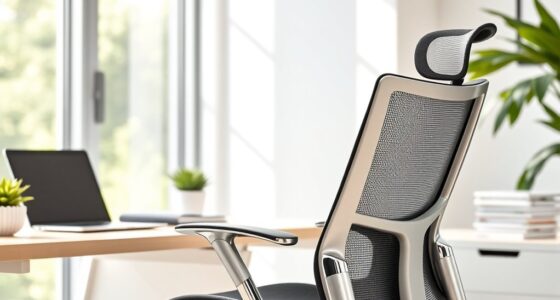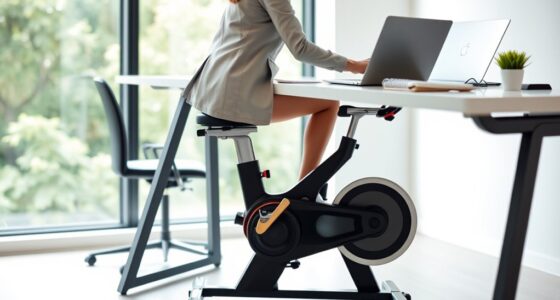Many myths about ergonomics, like believing a perfect chair guarantees comfort or that everyone should sit with the same posture, can actually harm you. Proper ergonomics isn’t just about instant fixes or rigid rules, but about personal adjustments and listening to your body. Stretching, movement, and tailored solutions matter more than blindly following trends or spending a lot. Understanding these misconceptions can help you find what truly supports your health—if you want to know more, you’re in the right place.
Key Takeaways
- Relying solely on adjustable features or labels like “ergonomic” doesn’t guarantee comfort; personalization is essential.
- Believing in a single “perfect” posture ignores individual differences and natural movement, risking unnecessary strain.
- Instant ergonomic adjustments can improve comfort immediately but shouldn’t replace long-term habits and proper positioning.
- Thinking ergonomic products are expensive or unnecessary may lead to neglecting vital health benefits and injury prevention.
- Overemphasizing rigid correctness over comfort and flexibility can cause discomfort and overlook the importance of movement.
Ergonomic Furniture Guarantees Comfort
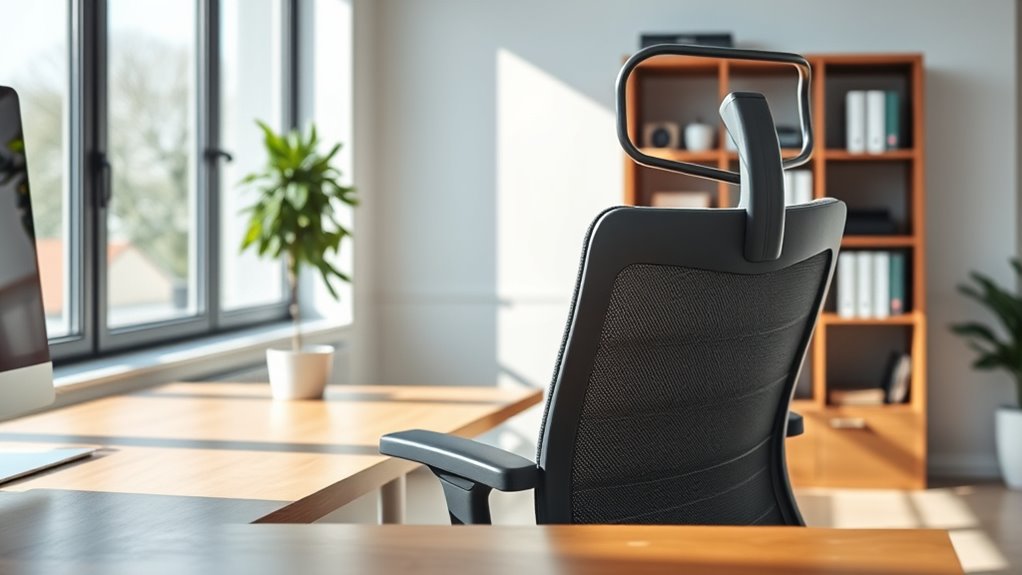
Many people assume that simply buying ergonomic furniture will automatically guarantee comfort. While features like adjustable components—such as seat height, armrests, and lumbar support—are essential, they don’t guarantee comfort on their own. The key is understanding that ergonomic furniture with proper certifications indicates it has been tested for safety and effectiveness, but comfort still depends on how well you personalize these adjustable features to your body. Just because a chair is labeled “ergonomic” doesn’t mean it will fit you perfectly right out of the box. You need to take the time to adjust it correctly, ensuring proper alignment for your posture. Ultimately, comfort comes from a combination of quality, certification, and your ability to customize the furniture to suit your needs. Additionally, ergonomic design plays a crucial role in ensuring that the furniture supports your body effectively, reducing strain and enhancing comfort over time.
Proper Posture Is the Same for Everyone

You might think everyone should sit the same way, but individual body differences mean what’s comfortable for one person isn’t for another. Your posture needs depend on your height, build, and any existing issues, so a one-size-fits-all approach doesn’t work. Custom ergonomic adjustments help guarantee you stay comfortable and reduce strain. Recognizing individual differences is essential for effective ergonomic practices.
Individual Body Variations
Although common advice suggests that there is a single perfect posture for everyone, individual body variations mean that what feels comfortable and safe can differ from person to person. Your muscle flexibility and joint health play significant roles in determining what posture works best for you. If you have tight muscles, maintaining a rigid position may cause discomfort or strain, while those with more flexible muscles might find certain positions less supportive. Likewise, joint health influences how your joints tolerate sustained positions; some people may need to adjust their posture to avoid pain or stiffness. Recognizing these differences is vital. Instead of blindly following generic rules, listen to your body and adapt your workspace to suit your unique physical needs. Incorporating individual differences into ergonomic practices helps prevent discomfort and long-term injuries.
Posture Needs Differ
While understanding that individual body differences matter is important, it’s a misconception that there’s one correct posture for everyone. Your personal preferences play a big role in what feels comfortable and sustainable. Cultural differences also influence how people sit, stand, or work, shaping their ideas of proper posture. For some, crossing legs or leaning forward might be natural, while others prefer an upright, relaxed position. The key isn’t to force a universal ideal but to find a posture that supports your comfort and reduces strain. Recognizing that posture needs vary helps you avoid unnecessary discomfort and injury. Instead of chasing a “perfect” posture, focus on what feels best for you, respecting your body’s unique cues and your cultural background. Additionally, understanding that ergonomics principles can be adapted to individual needs promotes healthier habits tailored to your lifestyle.
Custom Ergonomics Matter
Many believe that there is a universal ideal for proper posture that applies to everyone, but this isn’t accurate. Your body diversity means personal customization is essential to find what works best for you. Instead of following a one-size-fits-all approach, focus on tailoring your ergonomic setup to your specific needs. Proper posture varies based on factors like height, limb length, and joint flexibility. Considering individual tax implications can also influence how you set up your workspace and plan your retirement strategies to optimize overall well-being.
Sitting Up Straight Is Always the Best Choice

Sitting up straight isn’t always the best way to keep your spine healthy. Proper alignment matters more than rigidity, so find a position that feels comfortable and supports your back. Remember, comfort can help you stay focused without sacrificing your spine’s well-being. Incorporating ergonomic principles into your workspace can further reduce strain and improve overall posture.
Proper Spine Alignment
Although it’s often advised to sit up straight, insisting that you must always maintain perfect spinal alignment can be misleading. Your spine is designed for movement and flexibility, so rigidly holding a specific position isn’t necessary. Instead, focus on maintaining good lumbar support to support the natural curve of your lower back. Proper spinal alignment means your ears, shoulders, and hips are roughly in line, reducing strain. Remember, discomfort isn’t always a sign of poor posture; listen to your body. To promote healthy spine alignment:
- Use lumbar support to reduce pressure on your lower back
- Keep your feet flat on the floor
- Adjust your chair height for comfortable arm positioning
- Take regular breaks to stretch and change positions
- Be aware of regular gym hours to maintain consistency in your fitness routine. Prioritize comfort and support over strict rules for sitting perfectly.
Comfort Over Rigidity
While it’s common to hear that you should always sit up straight, prioritizing comfort often leads to better overall health. Rigidly forcing yourself into a perfect posture can cause tension and discomfort, which may reduce productivity and increase stress. Instead, listen to your personal preferences and find a position that feels natural and supportive. Comfort doesn’t mean neglecting good ergonomics; it means balancing support with ease of movement. Aesthetic considerations, like how your workspace looks, shouldn’t override your comfort needs. When you choose a chair and setup that feel right for you, you’re more likely to maintain good posture naturally. Additionally, considering proper ergonomic alignment can help prevent long-term strain. Remember, ergonomic comfort encourages sustained focus and reduces strain, making your workspace healthier and more sustainable.
Ergonomics Is Only Important for Office Workers

Many people assume that ergonomics only matters for office workers, but in reality, anyone who spends time at a desk or performs repetitive tasks can benefit from ergonomic principles. Whether you’re working remotely, gaming, or doing household chores, proper ergonomics helps prevent strain and injury. If you’re engaging in remote work, investing in ergonomic accessories like adjustable chairs, footrests, or keyboard supports can make a big difference. Remember, poor posture isn’t exclusive to office settings; it affects anyone sitting for extended periods. By applying ergonomic tips, you can boost comfort and productivity in all areas of life. Don’t overlook the importance of ergonomics outside traditional office environments—your body will thank you. Additionally, understanding ergonomic principles can help you tailor your workspace to reduce the risk of musculoskeletal issues.
You Can Achieve Perfect Ergonomics Instantly
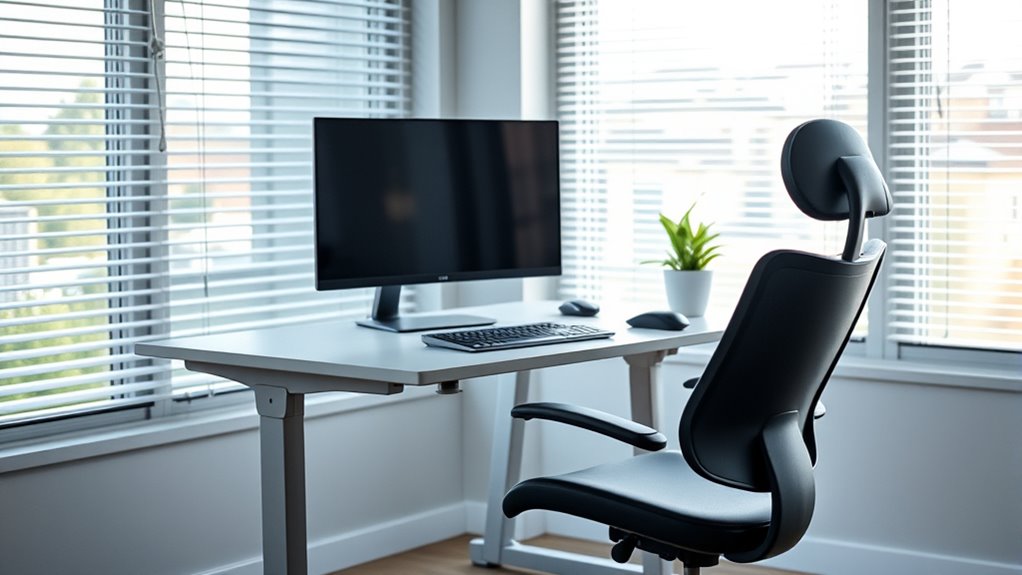
Is achieving perfect ergonomics truly possible in an instant? The answer is yes, if you focus on tools that offer instant adjustment and a universal fit. Many ergonomic products are designed to adapt quickly, allowing you to customize your setup immediately. For example, adjustable chairs with simple levers let you tweak height and lumbar support on the spot. Similarly, ergonomic keyboards and mouses with universal fit features fit most users comfortably without complex setup. While perfect ergonomics might seem like a distant goal, these instant adjustments help you find a comfortable, healthy position instantly. Remember, achieving good ergonomics isn’t about perfection but making quick, effective changes that reduce strain and improve comfort right now. Additionally, considering ergonomic principles in the context of a Bedroom can promote overall well-being and comfort in your daily environment.
Ergonomic Solutions Are Too Expensive to Be Worth It

Investing in ergonomic solutions might seem costly at first glance, but the long-term benefits often outweigh the initial expense. When you consider cost effectiveness, ergonomic upgrades can reduce health issues like back pain and repetitive strain injuries, saving you money on medical bills and lost productivity. Plus, you don’t always need expensive equipment; quick fixes like adjustable chairs, proper monitor height, or ergonomic accessories can make a significant difference without breaking the bank. These small investments can lead to increased comfort and focus throughout your day. Remember, avoiding ergonomic solutions may seem cheaper upfront, but the potential costs of discomfort and injury are far higher. Prioritizing ergonomic improvements is a smart, cost-effective way to protect your health and boost efficiency. Incorporating ergonomic solutions into your workspace can also help prevent long-term musculoskeletal problems.
Using Standing Desks Eliminates the Need to Sit
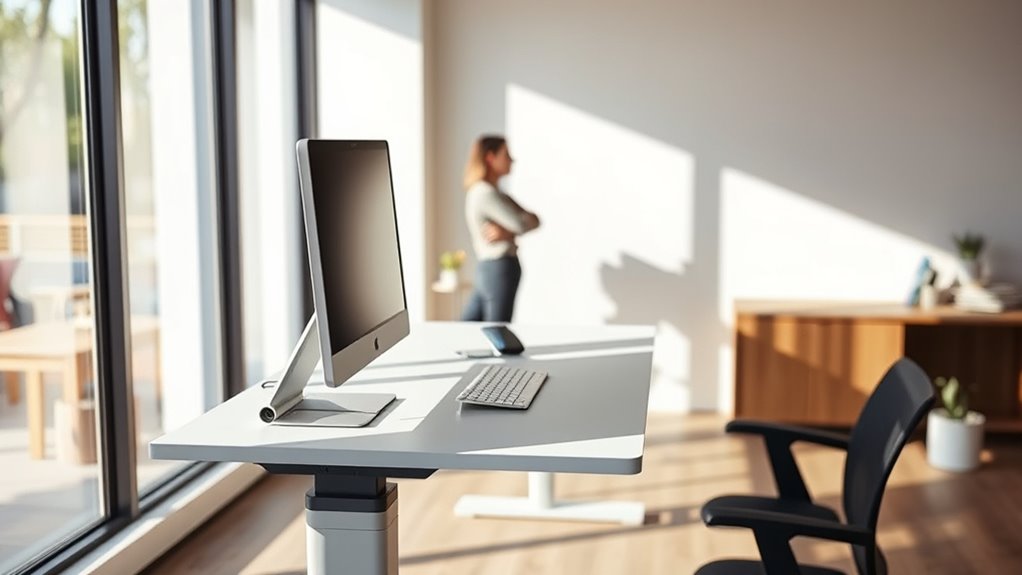
Using a standing desk can markedly reduce the need to sit for extended periods, promoting better posture and increased energy throughout the day. However, it doesn’t mean you should stand constantly. To avoid fatigue, you should alternate positions, switching between sitting and standing. This helps prevent strain and keeps your muscles engaged. Remember, a standing desk isn’t a one-size-fits-all solution; personalized adjustments are key. Adjust the height so your elbows are at a 90-degree angle and your monitor is at eye level. Incorporating movement and varying your position throughout the day helps you stay comfortable and energized. Standing all day isn’t necessary or ideal—alternating positions with proper adjustments is the best approach to support your health and productivity.
Ergonomics Is Just a Trend, Not a Necessity

Many people dismiss ergonomics as just another passing trend, believing it’s more about style than function. However, ergonomic misconceptions can lead to discomfort or injury if ignored. Ergonomics isn’t a one-size-fits-all solution; it emphasizes personal customization to suit your unique body and work habits. Treating ergonomics as a fad dismisses its importance in preventing strain and long-term health issues.
A strong understanding of resources and tools can help you implement effective ergonomic practices tailored to your needs.
Good Ergonomics Means Sacrificing Comfort for Correctness

Achieving good ergonomics often requires you to prioritize proper alignment and posture over immediate comfort. This might mean adjusting your chair, keyboard, or monitor, even if it feels slightly uncomfortable at first. Sacrificing some comfort helps prevent muscle tension and reduces long-term strain. While it might seem less cozy, correct positioning minimizes muscle tension that can cause fatigue and pain. It also helps you stay focused, as discomfort and poor posture can lead to mental distraction. Remember, ergonomics isn’t about suffering through discomfort but about making minor sacrifices now for healthier habits later. Proper ergonomics ensures your body stays aligned, reducing muscle tension and improving concentration, ultimately making your workspace more efficient and less harmful in the long run. Checking support hours can help you find assistance if you experience issues with your ergonomic setup.
Frequently Asked Questions
Can Ergonomic Furniture Cause Discomfort if Not Properly Adjusted?
If you don’t properly adjust your ergonomic furniture, it can cause discomfort. Adjustment challenges might lead to ergonomic mismatches, where your chair or desk doesn’t support your body correctly. This can result in strain and pain over time. To avoid this, take the time to fine-tune your setup, ensuring your chair height, lumbar support, and monitor position suit your body’s needs. Proper adjustment is key to comfort and health.
How Do Individual Differences Affect Ergonomic Needs?
Your individual differences play a big role in your ergonomic needs. Personal differences like height, body shape, and mobility influence how you should customize your workspace. You should prioritize ergonomic customization to fit your unique body and preferences, rather than relying on generic setups. By adjusting your chair, desk, and monitor height, you reduce discomfort and prevent strain, ensuring a more comfortable and productive work environment tailored specifically for you.
Is There an Ideal Sitting Posture for Everyone?
You might wonder if there’s an ideal sitting posture for everyone. The truth is, posture myths often suggest a universal ergonomics approach, but individual differences matter. Instead of trying to find a perfect position, focus on staying comfortable and maintaining movement. Adjust your chair, monitor, and desk to suit your body. Remember, good ergonomics means personalized comfort, not rigid adherence to a one-size-fits-all posture.
Are Ergonomic Solutions Effective Outside the Office Environment?
Think of ergonomic solutions as your personal health compass, guiding you beyond the office walls. You can improve your posture, comfort, and focus no matter where you are, boosting workplace productivity and preventing pain. Whether at home, in a coffee shop, or on the go, ergonomic tools adapt to your environment, making healthy habits a natural part of your daily routine. Yes, these solutions are just as effective outside the traditional office setting.
How Quickly Can Ergonomic Improvements Reduce Pain or Injury?
When you make ergonomic adjustments, pain relief speed varies, but some improvements can reduce discomfort within days. Adjustment timelines depend on the issue’s severity and your consistency in maintaining proper posture. You might notice less pain or fewer injuries in just a week, especially if you address key areas like your chair height or monitor position. The sooner you implement these changes, the quicker you’ll experience relief and prevent future injuries.
Conclusion
Don’t let these myths trap you in discomfort. Ergonomics isn’t a one-size-fits-all magic wand, but a guide to making your workspace work for you. Think of it as tuning a guitar—you need to adjust, not just set and forget. Embrace personalized solutions, invest wisely, and remember that comfort and health are worth the effort. Your well-being is the melody you should never stop playing.


